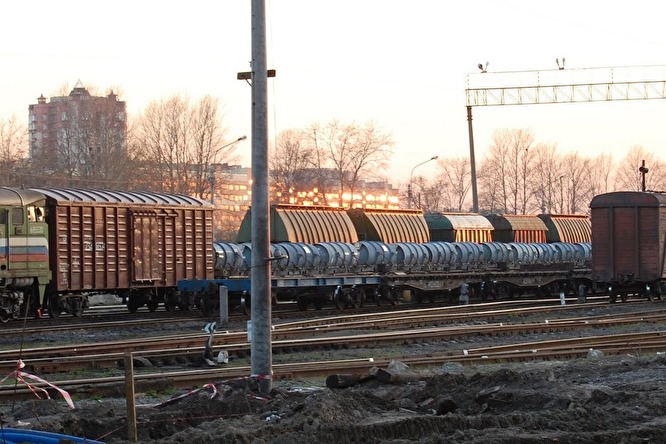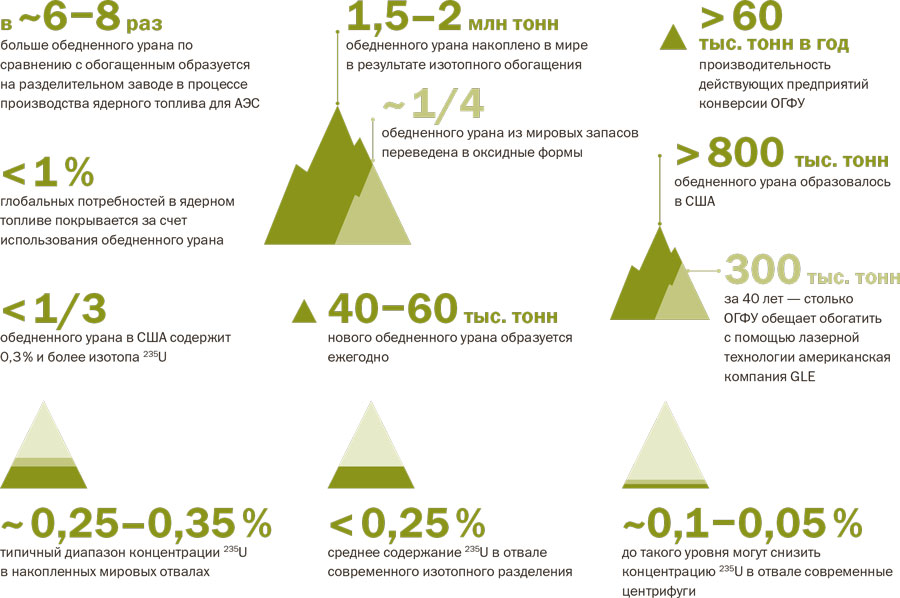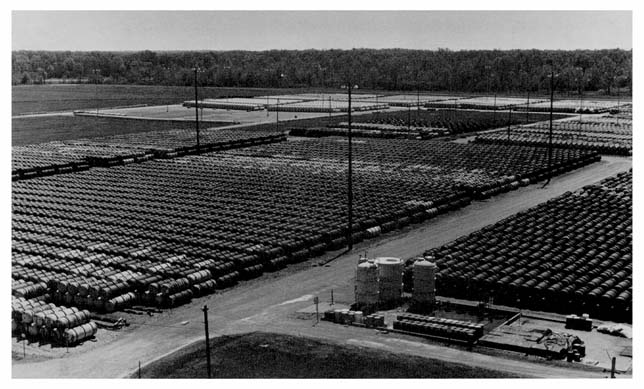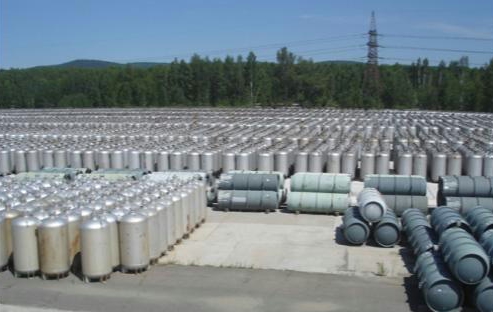But a lot has changed in 10 years. For example, legislation on radioactive waste management in Russia has improved significantly, but the situation with independent public organizations, including environmental - deteriorated due to general pressure on civilian institutions. At the same time, which is characteristic, the essence of the problem of importing and processing depleted uranium hexafluoride and the argument of the parties have not changed.
What is the point? Let's point by point.

Photos of imported "waste". Source - Znak.com .
1. A bit of equipment. Natural uranium consists of 0.7% of the uranium-235 isotope and 99% of the uranium-238 isotope. For use in nuclear energy or nuclear weapons, as nuclear physics tells us, it is necessary to increase the proportion of uranium-235 to at least 3-4% (for nuclear power plants), and sometimes up to 90% (weapons-grade uranium). They increase this share in the enrichment process at special centrifuges at plants, the largest of which (in my opinion, even in the world) are located just in Novouralsk (this is UEHK). At the same time, natural uranium yields useful uranium enriched to the desired value at the 235th isotope, and dump (so-called “tails”) uranium - depleted at the 235th isotope to 0.3-0.2%, or even lower . Moreover, the second by volume is much larger (roughly - up to 90%).
2. The USA and Russia (USSR), as well as just a few other countries, have been engaged in uranium enrichment for more than half a century, and about two million tons have already been accumulated in depleted uranium. At the same time, enrichment technologies have changed more than once (apart from exotics, there has been a massive transition from diffusion to centrifugal technology), and they are still constantly being improved, and the uranium that went to the dump earlier can now be used again as raw material from which it can be extracted more and more uranium-235. Moreover, the technologies, even at the moment, are not the same everywhere. In Russia, and there is something to be proud of, centrifuge enrichment technology is the most efficient and cheapest (although nothing lasts forever and China is actively studying enrichment as well). Therefore, the fact that the European Urenco (and this is the second largest company in the world after Rosatom TVEL, which is engaged in uranium enrichment) is already dumping, it can be enriched further with a useful product.

Depleted uranium in facts and figures. Source - Atomic expert.
3. Duck waste transported to us or not? This is the most important question, and it is more philosophical, because from a legal point of view, everything is quite clear - this is not waste. In this sense, Rosatom, which claims that Greenpeace is engaged in misinformation, is right in its own way. According to Russian laws, radioactive waste is something that is no longer subject to further use. And if it is, then this is not a waste. After all, household garbage, if the necessary technologies are available, can turn from garbage into raw materials for recycling. So, our uranium enrichment technologies allow us to obtain a useful product from European “waste” as from recycled materials that is returned to the customer, and secondary depleted uranium is also formally not a waste, because in the future, it can also be used to obtain other useful products - fuel for fast reactors (this is a Russian chip, Europeans do not have such an option), because even uranium-238, acids and fluorine-containing compounds from uranium hexafluoride “burn” in them (this is already being done in Zelenogorsk , while converting uranium to a more stable and safe compound), etc. Americans, for example, at one time used depleted uranium to make armor for tanks, cores for shells, and even counterweights for civilian Boeing. But this is all legally understandable, but in the spirit of course the issue remains debatable, and all around it are debated. Moreover, in different countries the answers to these questions are different and often this is the result not even of technology, but of a social contract within the country. For example, the same spent nuclear fuel somewhere (in the USA, Sweden, etc.) is considered waste and must be disposed of, while in others (France, Russia) it is considered raw material, stored and reprocessed. And this is normal. Another thing is that the level of taking into account public opinion and work with civil society in different countries is different. And on these contradictions and different approaches, the opinions of Greenpeace and the German Greens on the one hand, and nuclear scientists and Rosatom on the other, clash. And the bewildered Russian public, or rather the part of it that is concerned about this issue, is lost in conjecture about who to believe and what to fear.

Depleted uranium storage in Russia.

Depleted Uranium Storage in the USA. The appearance of these storages is almost the same everywhere. A source.
4. Now regarding what remains of all these reprocesses in Russia, and whether we are trying to make a nuclear landfill (spoiler - no, although again, how to look). The fact is that after enrichment there remains secondary, even more depleted uranium, which by volume is about 90% of the original. And he remains in Russia. You can also consider it as future raw materials (theoretically, while it is not so in demand - it’s also enough of its own), but in fact it will be simply stored with us for a long time to come. And in this sense, some truth in the words of Greenpeace, which says that under the guise of processing most of this material is imported into Russia and remains, is. Those. attitude to this uranium is quite a place for public discussion, but where do we have it, even if the State Duma does not have a place for it. In my opinion, it would be more fair to send it back, because the benefits in accumulating its reserves for the future are not so obvious to us, if we have enough, and the risks are added. And then there would have been no questions at all, but there would have been almost (about "almost" lower) advantages: we earn on enrichment technologies, Europeans get a useful product, and take away less demanded dump uranium.
5. About the "almost." Everything would be fine, and it would be possible to transport uranium back and forth for reprocessing, but the transportation itself, as well as the storage of uranium, is still potentially associated with risk. Like any technology, however. Moreover, this risk is not even associated with radiation - in depleted uranium, the more active isotope is less, i.e. it is less radioactive than natural uranium, and even enriched uranium fuel can be safely held in your hands and be near it (tested on yourself). But from a chemical point of view, this thing will be worse. Uranium is transported and processed not in its pure form, but in the form of a compound with fluorine - uranium hexafluoride (in centrifuges it is generally enriched in gaseous form). Upon contact with moisture, hydrofluoric acid may form. Therefore, it is transported and stored in airtight steel containers. But there are technologies for converting it to nitrous oxide, which is much safer and more stable. About a quarter of the world's depleted uranium reserves are converted into this form - mainly in France (there they are legally obliged to do this ), and in our country this process is partially carried out in Zelenogorsk and in some form in Angarsk.

Uranium defluorination shop in Zelenogorsk. A source.

Depleted uranium storage in Zelenogorsk. A source.
But even without the translation of DUHF, one must understand here that we are again dealing with some radiophobia and bias. Since such materials, toxic and chemically hazardous, such as chlorine, ammonia, hydrochloric acid, etc., are produced and transported daily by orders of magnitude more than uranium hexafluoride. And people are able to work with similar hazardous substances. Although of course this does not eliminate the need for close monitoring of these processes, including by the public. But for some reason, special attention is paid to precisely what is connected with radiation and nuclear horror stories.
So let's somehow without unnecessary panic, and with great attention to the opinions of others.
PS: Useful links:
- An excellent analysis of the problem of OGFU in the world from the journal "Atomic Expert" - link .
- Interview with Alexander Nikitin.
- The material on Znak (there is a series, but this is the last one so far) about the reaction of the German greens, with a survey of different sides, including Rosatom.
- Old 2009 article on the conversion of DUHF to oxide forms in Zelenogorsk - link